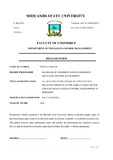Please use this identifier to cite or link to this item:
https://cris.library.msu.ac.zw//handle/11408/2789| Title: | An analysis of the uptake of agricultural insurance services by the agricultural sector for sustainable socio economic development in Zimbabwe | Authors: | Topoya, Trevor | Keywords: | Agricultural insurance services Sustainable socio economic development |
Issue Date: | 2016 | Publisher: | Midlands State University | Abstract: | The purpose of this research was to analyse the uptake of agricultural insurance services by the agricultural sector for sustainable socio economic development in Zimbabwe. The research covered the period of 2000 to 2015. The research focused on A1 and A2 farmers which consisted of subsistence and small-medium scale commercial farmers. Agriculture is a risky enterprise due to its cyclical nature, risk of loss from fires and natural disasters. The researcher established that agricultural insurance is an important complement to a wholesome, development-oriented agriculture risk management strategy. Furthermore, the advent of innovative agriculture insurance products such as index-based and microinsurance has provided new ways of countering the risks that would otherwise thrust farmers and many other households into poverty and deprivation. The benefits of agriculture insurance contribute positively towards socio economic development. Ironically, the uptake of agriculture insurance by farmers in Zimbabwe is low. Farmers cited various reasons for not taking up agriculture insurance chief among them are affordability and lack of knowledge on how the insurance operates. On the other hand, the local insurers are reluctant to provide comprehensive cover and the policies offered exclude risks such as drought, which affect famers the most. The rationale for this stance is to protect the insurers’ bottom line against anomalies such as moral hazard, adverse selection and fraud. Random sampling was used to select 10 short term insurance companies out of a total of 20 short term insurance companies registered with IPEC. More so, non-random sampling particularly convenience sampling was used to come up with the sample of farmers. Data was collected through the use of questionnaires and interviews. The data was then analyzed and presented using tables, graphs and charts. The researcher presented conclusions from the research findings and made recommendations aimed at addressing them such as educate farmers on the importance of agricultural insurance on farm operations and insurance products and how the insurance market operates in general, insurers should locate closer to their market and increase their branch network, especially in agricultural thriving areas, to enhance service delivery and the government should subsidise agriculture insurance premiums to enhance uptake by farmers. | URI: | http://hdl.handle.net/11408/2789 |
| Appears in Collections: | Bachelor Of Commerce Insurance And Risk Management Honours Degree |
Files in This Item:
| File | Description | Size | Format | |
|---|---|---|---|---|
| R132427Y.pdf | Full Text | 1.52 MB | Adobe PDF |  View/Open |
Page view(s)
354
checked on Feb 26, 2025
Download(s)
264
checked on Feb 26, 2025
Google ScholarTM
Check
Items in MSUIR are protected by copyright, with all rights reserved, unless otherwise indicated.


